This book constitutes the refereed proceedings of the 32nd International Conference on Computer Safety, Reliability, and Security, SAFECOMP 2013, held in Toulouse, France, in September 2013.
The 20 revised full papers presented together with 5 practical experience reports were carefully reviewed and selected from more than 88 submissions. The papers are organized in topical sections on safety requirements and assurance, testing and verification, security, software reliability assessment, practical experience reports and tools, safety assurance in automotive, error control codes, dependable user interfaces, and hazard and failure mode analysis.
